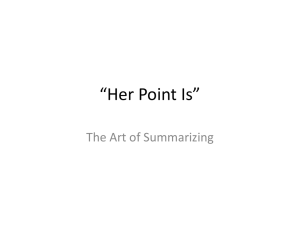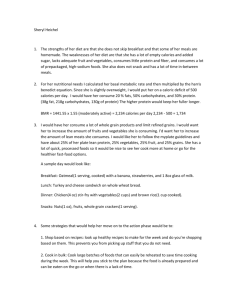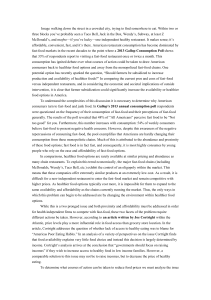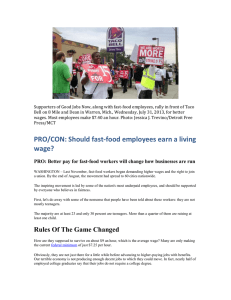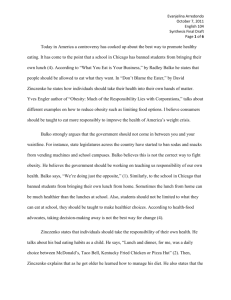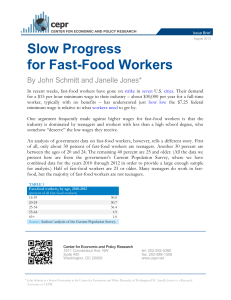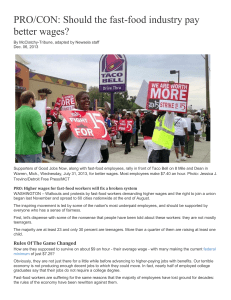Don`t Blame the Eater - Warren County Schools
advertisement
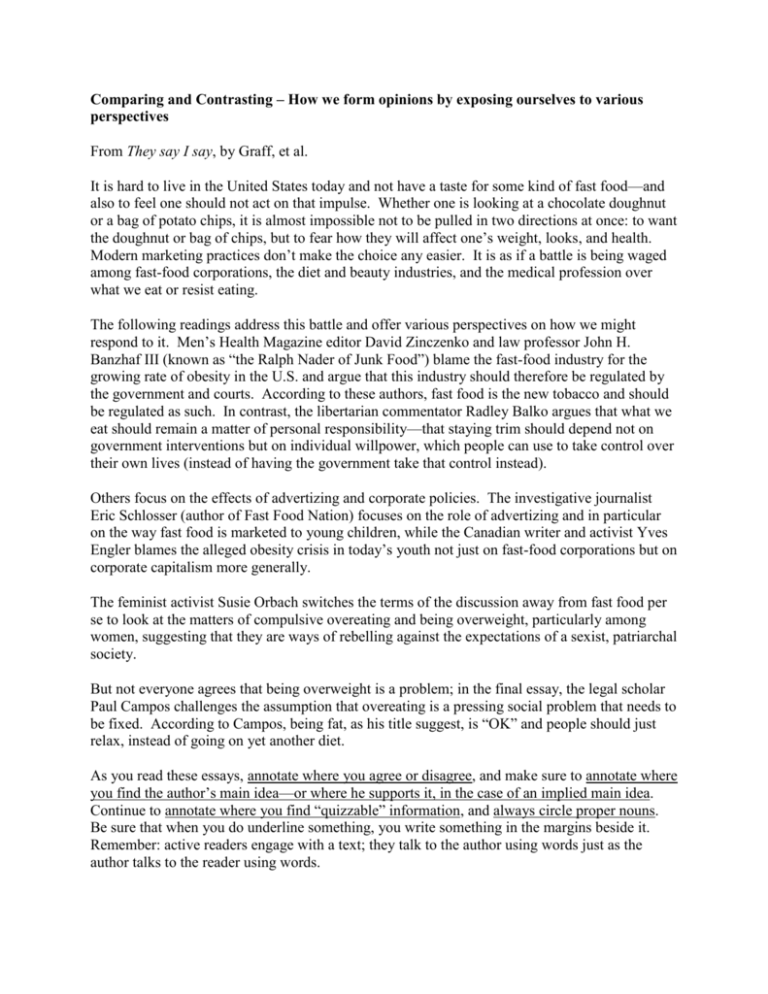
Comparing and Contrasting – How we form opinions by exposing ourselves to various perspectives From They say I say, by Graff, et al. It is hard to live in the United States today and not have a taste for some kind of fast food—and also to feel one should not act on that impulse. Whether one is looking at a chocolate doughnut or a bag of potato chips, it is almost impossible not to be pulled in two directions at once: to want the doughnut or bag of chips, but to fear how they will affect one’s weight, looks, and health. Modern marketing practices don’t make the choice any easier. It is as if a battle is being waged among fast-food corporations, the diet and beauty industries, and the medical profession over what we eat or resist eating. The following readings address this battle and offer various perspectives on how we might respond to it. Men’s Health Magazine editor David Zinczenko and law professor John H. Banzhaf III (known as “the Ralph Nader of Junk Food”) blame the fast-food industry for the growing rate of obesity in the U.S. and argue that this industry should therefore be regulated by the government and courts. According to these authors, fast food is the new tobacco and should be regulated as such. In contrast, the libertarian commentator Radley Balko argues that what we eat should remain a matter of personal responsibility—that staying trim should depend not on government interventions but on individual willpower, which people can use to take control over their own lives (instead of having the government take that control instead). Others focus on the effects of advertizing and corporate policies. The investigative journalist Eric Schlosser (author of Fast Food Nation) focuses on the role of advertizing and in particular on the way fast food is marketed to young children, while the Canadian writer and activist Yves Engler blames the alleged obesity crisis in today’s youth not just on fast-food corporations but on corporate capitalism more generally. The feminist activist Susie Orbach switches the terms of the discussion away from fast food per se to look at the matters of compulsive overeating and being overweight, particularly among women, suggesting that they are ways of rebelling against the expectations of a sexist, patriarchal society. But not everyone agrees that being overweight is a problem; in the final essay, the legal scholar Paul Campos challenges the assumption that overeating is a pressing social problem that needs to be fixed. According to Campos, being fat, as his title suggest, is “OK” and people should just relax, instead of going on yet another diet. As you read these essays, annotate where you agree or disagree, and make sure to annotate where you find the author’s main idea—or where he supports it, in the case of an implied main idea. Continue to annotate where you find “quizzable” information, and always circle proper nouns. Be sure that when you do underline something, you write something in the margins beside it. Remember: active readers engage with a text; they talk to the author using words just as the author talks to the reader using words. Don't Blame the Eater By David Zinczenko Published: November 23, 2002 Zinczenko is the editor in chief of Men’s health magazine and the author of numerous bestselling books, including Eat This, Not That. He has contributed op-ed essays to the New York Times, the Lost Angeles Times, and USA Today, and has appeared on Oprah, Ellen, 20/20, and Good Morning America. If ever there were a newspaper headline custom-made for Jay Leno's monologue, this was it. Kids taking on McDonald's this week, suing the company for making them fat. Isn't that like middle-aged men suing Porsche for making them get speeding tickets? Whatever happened to personal responsibility? I tend to sympathize with these portly fast-food patrons, though. Maybe that's because I used to be one of them. I grew up as a typical mid-1980's latchkey kid. My parents were split up, my dad off trying to rebuild his life, my mom working long hours to make the monthly bills. Lunch and dinner, for me, was a daily choice between McDonald's, Taco Bell, Kentucky Fried Chicken or Pizza Hut. Then as now, these were the only available options for an American kid to get an affordable meal. By age 15, I had packed 212 pounds of torpid teenage tallow on my once lanky 5-foot-10 frame. Then I got lucky. I went to college, joined the Navy Reserves and got involved with a health magazine. I learned how to manage my diet. But most of the teenagers who live, as I once did, on a fast-food diet won't turn their lives around: They've crossed under the golden arches to a likely fate of lifetime obesity. And the problem isn't just theirs -- it's all of ours. Before 1994, diabetes in children was generally caused by a genetic disorder -- only about 5 percent of childhood cases were obesity-related, or Type 2, diabetes. Today, according to the National Institutes of Health, Type 2 diabetes accounts for at least 30 percent of all new childhood cases of diabetes in this country. Not surprisingly, money spent to treat diabetes has skyrocketed, too. The Centers for Disease Control and Prevention estimate that diabetes accounted for $2.6 billion in health care costs in 1969. Today's number is an unbelievable $100 billion a year. Shouldn't we know better than to eat two meals a day in fast-food restaurants? That's one argument. But where, exactly, are consumers -- particularly teenagers -- supposed to find alternatives? Drive down any thoroughfare in America, and I guarantee you'll see one of our country's more than 13,000 McDonald's restaurants. Now, drive back up the block and try to find someplace to buy a grapefruit. Complicating the lack of alternatives is the lack of information about what, exactly, we're consuming. There are no calorie information charts on fast-food packaging, the way there are on grocery items. Advertisements don't carry warning labels the way tobacco ads do. Prepared foods aren't covered under Food and Drug Administration labeling laws. Some fast-food purveyors will provide calorie information on request, but even that can be hard to understand. For example, one company's Web site lists its chicken salad as containing 150 calories; the almonds and noodles that come with it (an additional 190 calories) are listed separately. Add a serving of the 280-calorie dressing, and you've got a healthy lunch alternative that comes in at 620 calories. But that's not all. Read the small print on the back of the dressing packet and you'll realize it actually contains 2.5 servings. If you pour what you've been served, you're suddenly up around 1,040 calories, which is half of the government's recommended daily calorie intake. And that doesn't take into account that 450-calorie super-size Coke. Make fun if you will of these kids launching lawsuits against the fast-food industry, but don't be surprised if you're the next plaintiff. As with the tobacco industry, it may be only a matter of time before state governments begin to see a direct line between the $1 billion that McDonald's and Burger King spend each year on advertising and their own swelling health care costs. And I'd say the industry is vulnerable. Fast-food companies are marketing to children a product with proven health hazards and no warning labels. They would do well to protect themselves, and their customers, by providing the nutrition information people need to make informed choices about their products. Without such warnings, we'll see more sick, obese children and more angry, litigious parents. I say, let the deep-fried chips fall where they may. 1) What does the title indicate about this reading’s content? 2) According to the author's information, can he be deemed a credible source on this topic? Why? 3) What are some words you don't know? What can you determine are their meanings based on how they are used in the sentence (if you can’t, consult a dictionary or do a Google search)? Portly ________________________________________________ Latchkey ________________________________________________ ________ ________________________________________________ ________ _________________________________________________ ________ _________________________________________________ ________ _________________________________________________ 4) How does the story he tells in paragraphs three and four about his own experience help support his argument or his credibility in making the argument? 5) In the fourth paragraph, the author gives a few statistics about children diabetes. Why does he include this? How might this type of evidence be more or less effective than something based more in emotional appeal? 6) Starting in paragraph five and continuing through to the end of the essay, the author tells the reader who is to blame. What factors are responsible for obesity in America if it isn’t the person doing the eating? 7) With what warning does he finish the essay? 8) According to this author, what needs to happen in order to stabilize this problem? The author argues that _____________________ and ____________________ are responsible for obesity in America, not the eater himself because the factors that are to blame make healthy lifestyles extremely difficult to lead. He warns that ______________________ may be needed to fix the problem.
